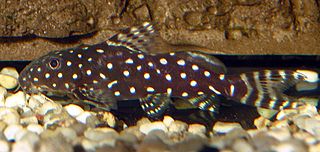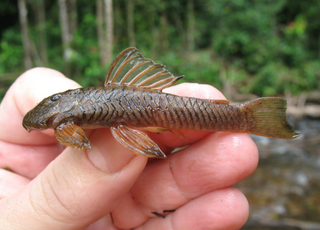
The walking catfish is a species of freshwater airbreathing catfish native to Southeast Asia. It is named for its ability to "walk" and wiggle across dry land, to find food or suitable environments. While it does not truly walk as most bipeds or quadrupeds do, it can use its pectoral fins to keep it upright as it makes a wiggling motion with snakelike movements to traverse land. This fish normally lives in slow-moving and often stagnant waters in ponds, swamps, streams, and rivers, as well as in flooded rice paddies, or temporary pools that may dry up. When this happens, its "walking" skill allows the fish to move to other aquatic environments. Considerable taxonomic confusion surrounds this species, and it has frequently been confused with other close relatives. One main distinction between the walking catfish and the native North American ictalurid catfish with which it is sometimes confused, is that the walking catfish lacks an adipose fin. It can survive 18 hours out of water.

Clarias is a genus of catfishes of the family Clariidae, the airbreathing catfishes. The name is derived from the Greek chlaros, which means lively, in reference to the ability of the fish to live for a long time out of water.

The firewood catfish a species of South American pimelodid catfish, is the sole member of the genus Sorubimichthys. Firewood catfish are one of the hundreds of freshwater fish in the in the Amazon Basin that play important ecological and economic roles. Known by locals along the Amazon Basin as peixe-lenha, the firewood catfish is so called because it is of little eating value and is often dried and used for firewood. Firewood catfish are imported to areas outside their native range as in-demand aquarium fish.
The narrowbar swellshark is a rare species of catshark, and part of the family Scyliorhinidae, known only from two specimens collected near Flinders Reef off northeastern Australia. This species reaches at least 44.5 cm (17.5 in) in length, and has a stocky body with a short, broad head. It can be readily identified by its zebra-like dorsal color pattern of transverse brown bars on a yellowish background. Like other swellsharks, it can inflate its body as a defensive measure.

Synodontis granulosus is a species of upside-down catfish endemic to the Democratic Republic of the Congo, Burundi, Zambia, and Tanzania, where it is only known from Lake Tanganyika. It was first described by Belgian-British zoologist George Albert Boulenger in 1900, from specimens collected at multiple points along the shore of Lake Tanganyika. The species name comes from the Latin word "granulum", meaning of grain, and refers to the granular papillae present on the skin of the fish's body.
Dichotomyctere kretamensis is a species of freshwater pufferfish known only from northern Borneo.

Synodontis angelicus is a species of upside-down catfish commonly named polkadot squeaker, black clown catfish, whitespotted squeaker, pearl squeaker, or angel squeaker. This species is native to the Congo Basin in the Democratic Republic of the Congo and the Republic of the Congo. It was originally described in 1891 by Belgian ichthyologist Louise Schilthuis after its discovery in the Malebo Pool of the Congo River. The specific name "angelicus" means heavenly or divine, since juveniles of this species are remarkable for their bright colors.

Synodontis batesii is a species of upside-down catfish native to rivers of Cameroon, the Democratic Republic of the Congo, Equatorial Guinea and Gabon. It was first collected by G. L. Bates and described by Belgian-British zoologist George Albert Boulenger in 1907, based upon holotypes discovered in the Dja River, near Bitye in Cameroon. The specific name "batesii" refers to the name of the collector of the first specimen.

Synodontis clarias, known as the red tailed synodontis, or the mandi, is a species of upside-down catfish that occurs widely in the waters of northern Africa. It was first described by Swedish zoologist Carl Linnaeus in 1758 as Silurus clarias. The original specimens were obtained in Egypt, near Cairo. The meaning of the species name clarias is not certain, but may possibly have been used to mean "bright" or "clear".
Synodontis tanganyicae is a species of upside-down catfish endemic to the Democratic Republic of the Congo, Zambia, and Tanzania, where it is only known from Lake Tanganyika. It was first described by Russian-American ichthyologist Nikolai Andreyevich Borodin in 1936, from specimens collected at Kasaga, in what is now the Democratic Republic of the Congo. The species name tanganyicae comes from the habitat of the species, Lake Tanganyika.
Synodontis irsacae is a species of upside-down catfish endemic to Zambia, the Democratic Republic of the Congo, and Tanzania, where it is only known from Lake Tanganyika. It was first described by Belgian ichthyologist Hubert Matthes in 1959, from specimens collected from Lake Tanganyika at Kalundu, in what is now the Democratic Republic of the Congo. The species name " irsacae" is derived from the abbreviation "I.R.S.A.C.", or Institut pour la Recherche Scientifique en Afrique Centrale. For many years, specimens of the species were considered to be juvenile members of S. dhonti, but in 2006, J.J. Wright and L.M. Page identified unique characteristics of this species that established that they were a unique species.

Guyanancistrus nassauensis is a species of catfish belonging to the family Loricariidae, the suckermouth armored catfishes. It is discovered in 2005 and formally described in 2018. G. nassauensis is a rare species, highly endemic to the Nassau Mountains in Suriname, and is threatened with extinction by proposed or ongoing mining activities.

Clarias kapuasensis is a species of clariid catfish from Borneo. It has been described from the upper part of the River Kapuas

Clarias peudoleiacanthus is a species of clariid catfish from Borneo. It has been described from the southern lower parts of the River Kapuas (Western Kalimantan and coastal areas near the Barito River in southern Kalimantan, Indonesia

Clarias intermedius is a species of clariid catfish from Indonesian Borneo. It has been described from Central Kalimantan, Indonesia, between the Sampit and Barito rivers.
Clarias pseudonieuhofii is a species of clariid catfish from Borneo. It has been currently described from the upper basin of the Kapuas River in West Kalimantan, in a geographic area bordering Sentarum Lake. It has been differed from C. nieuhofii by comparing the holotypes and paratypes from specimens of C. nieuhofii from Sumatra.
Clarias anfractus is a species of clariid catfish from Borneo. It is known from the Segama and Kalabakan drainages in Sabah, Northeastern Borneo.
Clarias planiceps is a species of clariid catfish from Borneo. It is known from tributaries all over Sarawak, and possibly up to Kapuas Hulu Regency.
Clarias monsembulai is a species of clariid catfish from the Congo Basin. It was named in honor of Raoul Monsembula Iyaba, a biology professor at the University of Kinshasa for collecting the type sample specimens and his contribution towards central African ichthyology. It has been described from a few rivers, namely Luilaka and Salonga, all near Salonga National Park.
Clarias insolitus is a catfish within the genus Clarias, found in the upper drainage of the Barito River, in Kalimantan, Indonesian Borneo.












